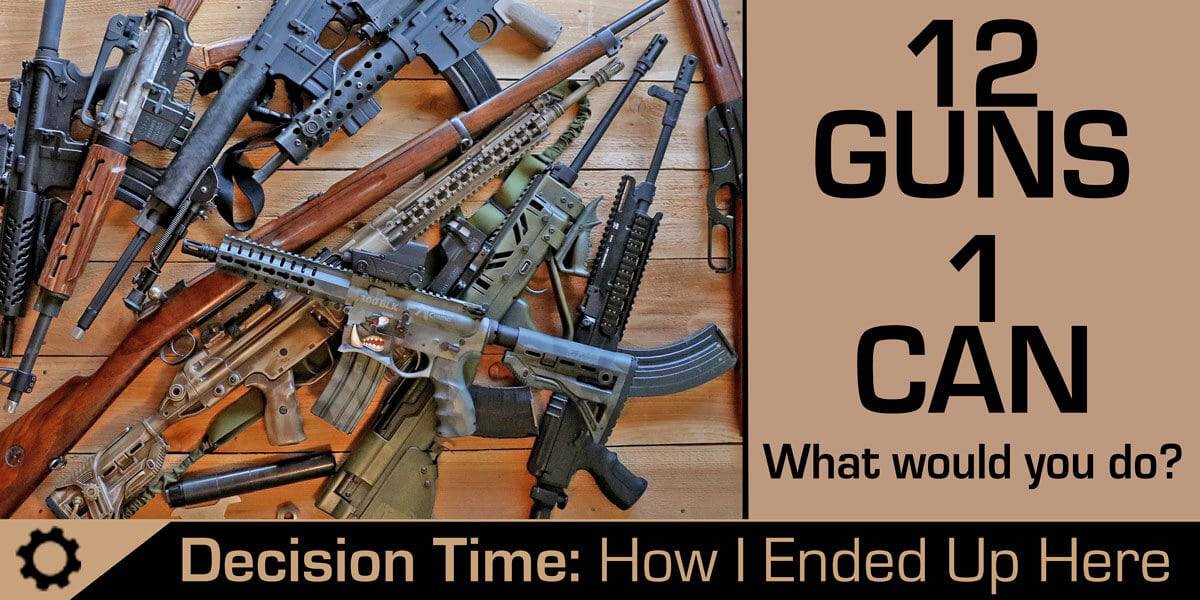 Suppressors are exploding in popularity because they are a good idea. They were a good idea back when Theodore Roosevelt installed one on his .30-30 to avoid annoying his Long Island neighbors, and they are a good idea today. Silencers are such a good idea that in many countries in Europe and around the world they are unrestricted, or even promoted by governments as safety devices. They protect hearing, keep ranges quiet, and reduce recoil without increasing muzzle blast and noise. What’s not to like Unfortunately, though, they face restrictions in the United States, which makes them more expensive and causes some hassle and time to be involved in the purchase of a suppressor.
Suppressors are exploding in popularity because they are a good idea. They were a good idea back when Theodore Roosevelt installed one on his .30-30 to avoid annoying his Long Island neighbors, and they are a good idea today. Silencers are such a good idea that in many countries in Europe and around the world they are unrestricted, or even promoted by governments as safety devices. They protect hearing, keep ranges quiet, and reduce recoil without increasing muzzle blast and noise. What’s not to like Unfortunately, though, they face restrictions in the United States, which makes them more expensive and causes some hassle and time to be involved in the purchase of a suppressor.
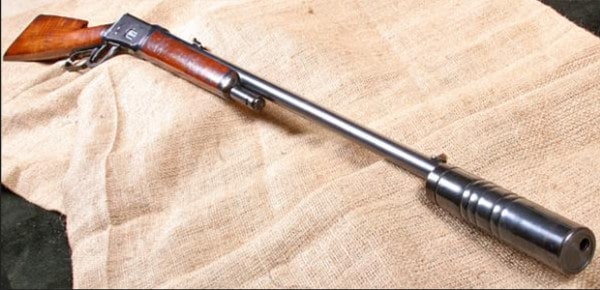
For Roosevelt, it seems, good manners dictated the use of a silencer
For hunting, the advantages of suppressors make them nearly essential, in my opinion. If hunting with an unsuppressed firearm, I use earplugs if at all possible to protect my hearing. I would rather risk losing an opportunity for a shot than to risk losing my hearing.
Similar to the growing popularity of long range shooting with magnum chambered rifles, many hunters use similar rifles and muzzle brakes to try to tame the heavy recoil of these guns. Other hunters are increasingly using short barrels in both magnum and standard chamberings. In both cases, the concussion with a brake can be so brutal that more and more hunting guides disallow the use of any brake on hunts that they guide. Quite the conundrum, right?
A good suppressor solves the puzzle and usually reduces recoil more than a brake does.
If practical, we’d probably all suppress any rifle we hunt with. Probably any gun we own. But if you own many rifles, this could become a major investment. Silencers are not inexpensive, and it makes sense to pay for a quality one. If you go too cheap, the tradeoffs can be lower quality, noise levels that are still unsafe, or more weight and length.
If we suppose that we have a .223 bolt action, a 5.56 AR, a .243 bolt gun, a .308 AR, 6.5 Grendel AR, your daughter’s .300 Blackout AR, .300 Win Mag, 7.62×39 AK, Swiss K31 for fun, an HK91, your wife’s 270, and a .30-30 lever action, to buy a suppressor for each one could easily run from $6,000 to $12,000 or more depending on the quality of the suppressors and what is required to mount them, plus dealer and tax stamp costs.
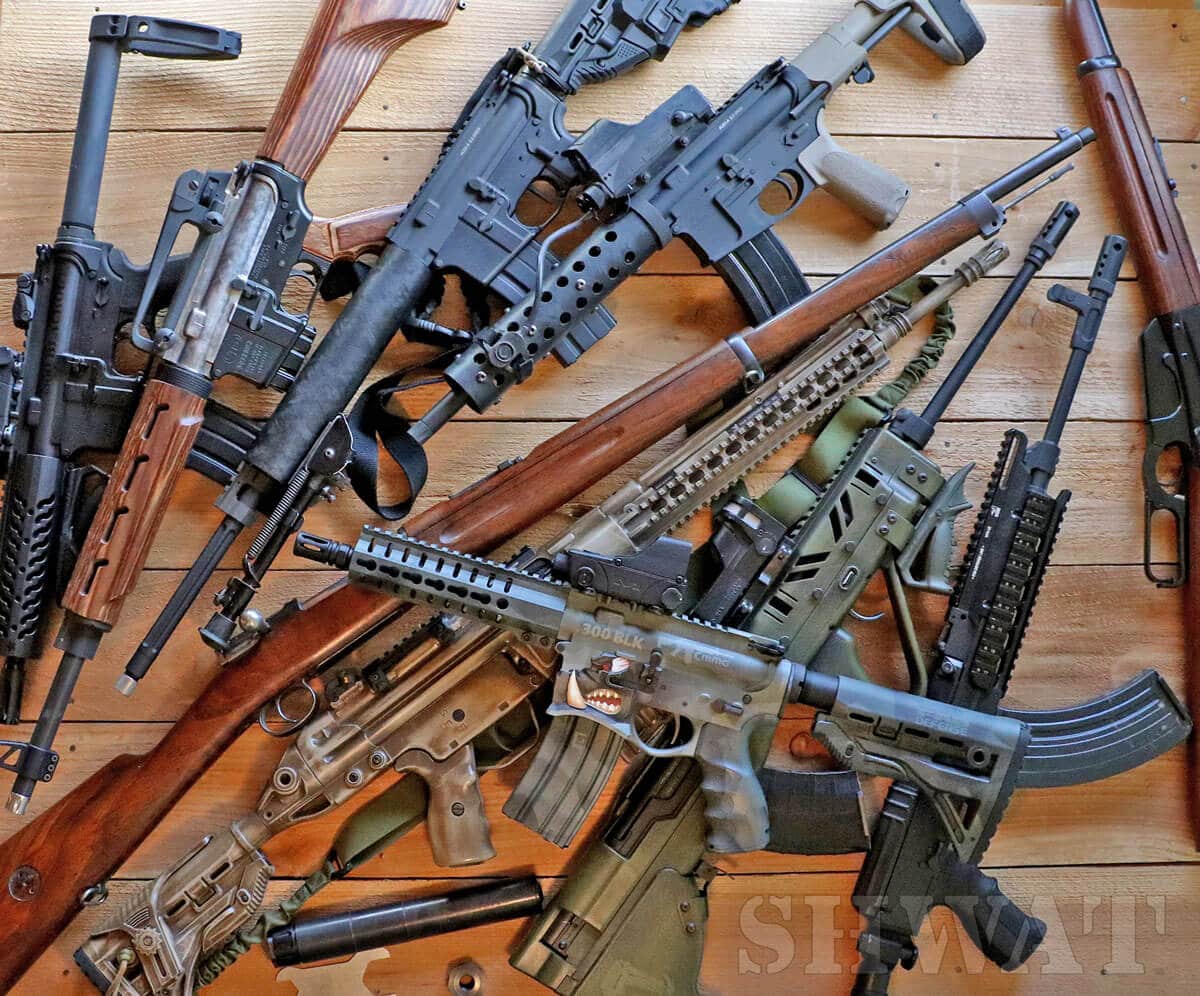 Because of this, the compromises we tend to make are to suppress fewer firearms and to purchase cheaper suppressors. Everything involving firearms is a tradeoff. We can’t have it all, all at once. The trick is to make educated and rational decisions about what tradeoffs give us the most benefit for what we need or want.
Because of this, the compromises we tend to make are to suppress fewer firearms and to purchase cheaper suppressors. Everything involving firearms is a tradeoff. We can’t have it all, all at once. The trick is to make educated and rational decisions about what tradeoffs give us the most benefit for what we need or want.
In choosing to suppress multiple firearms, here are the things that are important to me:
- I want quality suppressors. I don’t want to compromise quality for quantity, especially if that compromise is based solely on price.
- I want hearing-safe suppressors. When I hunt, I want my rifle to wear my hearing protection so that I can still hear on the hunt, and afterwards. After all, this is the purpose for suppressors. A suppressor that requires me to wear additional hearing protection does not fit my requirements. I don’t want to compromise this for a cheaper price, or for reduced weight or length.
- I want suppressors that are simple to mount and do not decrease accuracy. I will take simplicity over what people are hyping because they think it is cool, and I will take accuracy over some quick-change system that does not allow repeatable results.
- I want to be able to affordably suppress multiple firearms. I use many different guns because they fill different roles, have different advantages, or just because I like to. One of my requirements is to be able to suppress multiple firearms without spending too much money.
So how can I suppress multiple firearms while keeping the cost low?
Easy. When choosing a suppressor, don’t overlook the mounting system. This is key to affordably suppressing multiple rifles. It can also be key to repeatable accuracy, and simplicity. Some mounting systems required a lot of engineering, and this is naturally reflected in the price. I prefer something simple, inexpensive, and that mounts the suppressor securely in a repeatable way on multiple firearms.
One mounting system that fits this requirement is the Bowers Group Versadapt inserts for their AIMS mount system. By building a mounting system that uses interchangeable adaptors, Bowers Group is able to control the precision of the mounting system and simplify the mounting across multiple firearms. This would not be possible if shooters had to source third party thread adapters of dubious quality to adapt different barrel threads to the suppressor. Sounds crazy, but people do this all the time. Not SHWAT™ readers, of course, but they’re out there!
The Bowers Group amounting system is also dead simple and compact. Each suppressor ships with either an ATAS Insert (pistol suppressors) or a Versadapt Insert (rifle or sub gun suppressors). The inserts (which we can accurately refer to as ‘adapters’) screw into the rear of the silencer and thread directly onto your gun’s barrel. To adapt the suppressor from one firearm to another, just order an insert threaded for the second firearm’s barrel. To switch adapters, use the supplied wrench to unscrew the original adapter then screw the new adapter into the Bowers suppressor. Mounting is then as simple as spinning the silencer onto the second firearm.
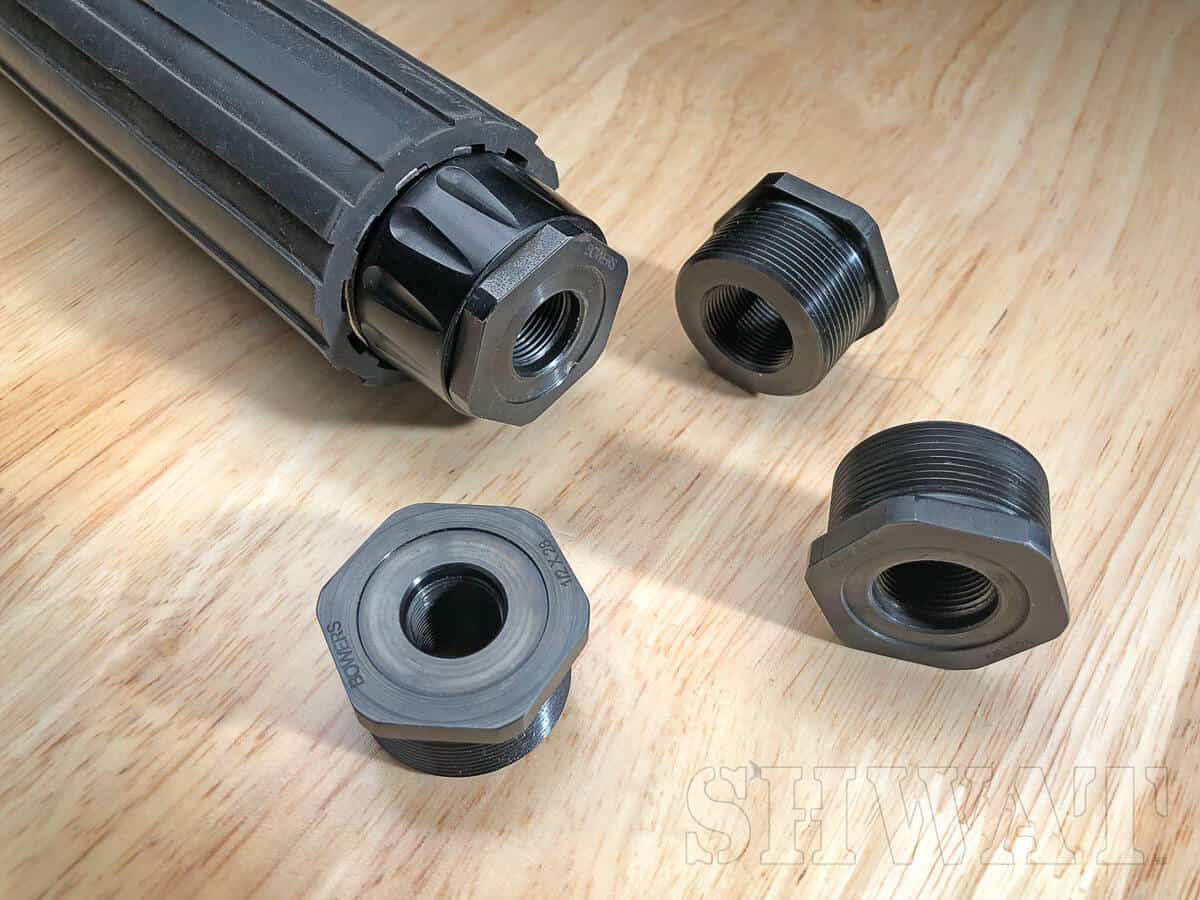
One can, many barrels.
Truth is, is took more time to type up this super simple procedure accurately than it takes for me to swap inserts when I want to use a different gun. The system is simple, fast, and affordable. It is designed and built for precision. With most of the Versadapt inserts priced at $45, suppressing multiple firearms is surprisingly affordable. Compared to other mounting systems which can often run $100 to $300 per adapter Bowers is a bargain.
What calibers can share the same suppressor?
It’s a great idea that with just a single can you can suppress a variety of calibers. But that only goes so far. A .50 caliber suppressor is not the best choice for suppressing a .243, nor is a .30 caliber rifle suppressor ideal for suppressing your .32 ACP pistol. But a good .30 caliber silencer will do an admirable job of suppressing a .243, 6.5 Creedmore, a .270 or 7mm Remington Magnum, your .308 AR, .300 Ultra Magnum, and Grandpa’s .30-06. You can even suppress your 5.56 with it.
For your .50 caliber Beowulf (or S&W 500, .50 Alaskan, .454, .45 Colt, .480 Ruger, etc.) you’ll need a bigger suppressor. The Bowers Vers 50 would be a great addition to a lever gun like your Marlin .45-70. With no ejection port barking noise back at you it will do a nice job of quieting the gun down while taming the recoil at the same time.
So in our example above we could suppress our dozen guns with one Bowers Vers 30 suppressor and 3 or 4 additional Versadapt inserts (depending on the variety of muzzle threads). The cost for 4 inserts would be $180, less than the cost of one or two quick-attach adapters for other types of suppressors.
In my case I wanted to suppress several firearms. I have a short .50 Beowulf and two 6.5 Grendel ARs that I use for bear protection and hunting. I have a couple of eight inch .300 Blackout ARs that are mostly fired by small children who would benefit from less recoil and noise. And I have a small pile of other firearms that I hunt with, shoot at the range, and are just plain fun to suppress.
It makes me smile when I think about it – All these guns can be suppressed with two Bowers suppressors: a Vers 50 and a Vers 30. Researching the suppressors, I was impressed by the quality and simplicity, and I wanted repeatable accuracy. I was especially attracted by the low cost and precision of the adapters and felt that the entire system fit my purposes perfectly. The Vers 50 suppressor is pretty much relegated to the .50 Beowulf, because, although I have some other calibers where it would work well (like .45-70, .45-75, etc.) they are chambered in firearms that I’m not willing to thread. Those are my collectibles. But the Vers 30, while primarily intended for .6.5 Grendel, will be getting a lot of use across a number of different firearms and calibers.
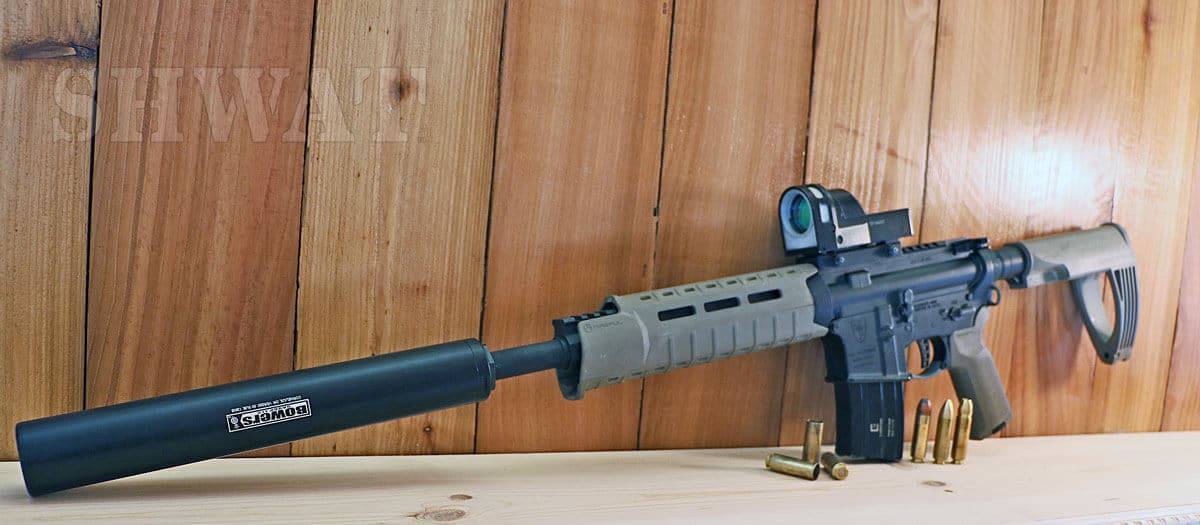 Other options, alternate conclusions
Other options, alternate conclusions
Your purpose and needs may lead you in a totally different direction. Maybe you need or just enjoy some of the quick attach cans on the market. Maybe you simply like the look of other brands. Perhaps cross compatibility with a buddy who cannot get his AAC muzzle device separated from his barrel factors into your decision. Maybe a lighter weigh silencer is important to you. But for me, the versatility, accuracy and real world suppression across multiple firearms were the factors that lead me here. What about you? Let us know in the comments!


I’m curious if you considered the OSS suppressors. Their pass through design fascinates me and I’m looking at buying two suppressors (30 cal and 9mm) for use on all my rifles and handguns.
They are on our list for a future project! Thanks!
I liked what you said about how you can quiet the gun and tame the recoil with a bowers vers 50. My husband is really wanting to get a silencer for his gun so it would be quieter. It would be really nice for him to be able to get a 9mm silencer from a professional.